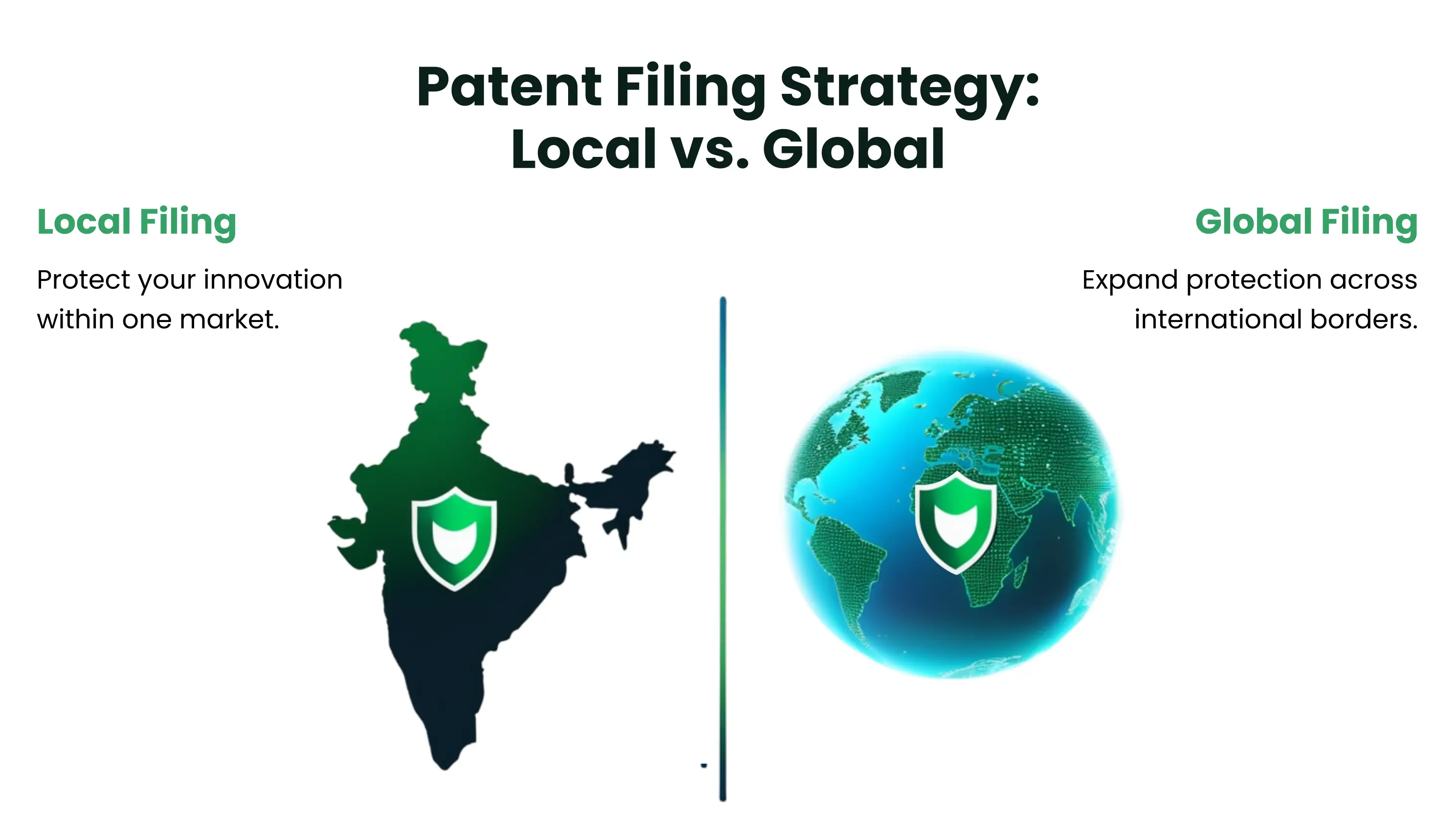
ENOVO on 23 Sep, 2025
Patent Filing Strategy: Local vs. Global – Which One Does Your Business Need?
Securing a patent is one of the smartest moves a business can make to protect innovation, maintain a competitive edge, and build long-term intellectual property (IP) value. However, a critical question arises during the patent filing strategy phase: should you pursue local patent filing in your home country like Pune, Maharashtra, India, or go for global patent filing to secure protection worldwide?
This decision isn’t just legal - it’s strategic. The right approach depends on your business goals, market expansion plans, budget, and competition. In this guide, we’ll explore local vs global patent filing, how the patent application process works, and which strategy is best suited for startups, SMEs, and growing enterprises.
What Is a Patent Filing Strategy?
A patent filing strategy is the structured plan businesses use to determine how to file a patent and where to protect their innovation in Pune, Maharashtra, India.
It includes:
- Identifying whether to file at the national level (local patents as in Pune) or through an international system (global patents).
- Understanding costs, timelines, and administrative requirements.
- Aligning IP protection with business strategy, ensuring patents support growth, funding, and global competitiveness.
A strong patent filing strategy balances protection, budget, and market opportunity.
The Patent Application Process: A Quick Overview
Before comparing local vs global patents, it helps to understand the general patent application process:
- Conduct a Patent Search – Ensure your invention is novel and not already patented.
- Draft the Patent Application – Include detailed specifications, claims, and illustrations.
- File the Application – Submit to the national patent office (local) or via international routes.
- Examination & Review – Authorities check novelty, usefulness, and industrial applicability.
- Grant & Protection – Once approved, you get legal rights to prevent unauthorized use.
This process can take anywhere from 18 months to several years, depending on the route chosen.
Local Patent Filing: Protecting Innovation at Home
Local patent filing means filing for protection in your home country. For instance, in Pune, Maharashtra, India, this is done through the national patent registration system at the Indian Patent Office.
Advantages of Local Patents
- Lower Cost – Filing nationally is less expensive than global routes.
- Quick Market Protection – Ideal if your business mainly operates in one region.
- Simpler Process – Less paperwork and fewer legal complexities compared to global filings.
- Best for Startups – Businesses testing their product in a single country can secure rights without heavy financial burden.
Local patent filing works well when your customers, competitors, and operations are primarily domestic.
Global Patent Filing: Expanding Beyond Borders
For companies targeting international markets, global patent filing is essential. While there’s no such thing as a “worldwide patent,” businesses can use international treaties like the Patent Cooperation Treaty (PCT) to streamline protection in multiple countries.
How PCT Patent Application Works
- File one PCT application to keep your option open in over 150 member countries.
- Delay country-specific filing (up to 30 months), giving you time to assess market opportunities.
- Simplify the process of international patent registration through a unified framework.
Advantages of Global Patents
- Wider Protection – Defend your invention in multiple countries at once.
- Global Business Strategy – Ideal for tech startups, pharmaceuticals, or products with worldwide demand.
- Investor Confidence – International patents strengthen valuation and attract funding.
- Competitive Edge – Protects against copycats in global markets.
Local vs Global Patent Filing: Key Differences
| Factor | Local Patent Filing | Global Patent Filing |
|---|---|---|
| Scope | Limited to one country | Multiple countries (via PCT/WIPO) |
| Cost | Lower, more affordable for startups | Higher, significant investment |
| Complexity | Easier, less legal work | More complex, multiple jurisdictions |
| Best For | SMEs, startups, local businesses | Export-driven, global-scale companies |
In short, local patents are cost-effective for businesses testing the market, while global patents are crucial for companies with international ambitions.
Which One Does Your Business Need?
The decision between filing a patent locally in Pune, Maharashtra, India or opting for global patent protection depends on:
- Business Model – Do you sell only domestically or plan international expansion?
- Budget – Can you afford the higher costs of global filing?
- Competitors – Are rivals mainly local or global players?
- Future Growth – Do you plan to scale into foreign markets within 5–10 years?
For Startups: A local patent filing is often the best patent strategy for startups. It provides immediate, affordable protection while validating the market. Later, you can expand through PCT filings.
For Growing Businesses: If your business has export potential or already attracts international customers, a global patent filing strategy should be part of your IP protection plan.
Business Patent Protection: Why Strategy Matters
Choosing the right patent strategy for businesses impacts more than legal security. It influences:
- Brand Value – Patents strengthen credibility and market positioning.
- Funding & Partnerships – Investors and partners prefer businesses with solid IP protection strategies.
- Revenue Opportunities – Patents can be licensed, creating new revenue streams.
- Defensive Strength – A well-planned patent portfolio protects against competitors and litigation.
A poorly planned approach, on the other hand, can lead to wasted resources or losing rights in critical markets.
FAQs
1. What is the main difference between local and international patents?
Local patents protect your invention in one country like in India, while international patents filed via PCT applications give you the option to protect your innovation in multiple countries.
2. Is local patent filing enough for startups?
Yes, in most cases. Filing a local patent in Pune, Maharashtra, India is cost-effective and offers quick protection, making it an ideal strategy for startups exploring domestic markets.
3. How much does global patent filing cost?
Global filings can cost significantly more—tens of thousands of dollars depending on the number of countries. However, it ensures broader protection and higher valuation.
4. Can I start with local patents and later move to global filing?
Yes. Many businesses first file locally and then file a PCT patent application within 12 months to secure global rights.
5. Which patent filing strategy suits small businesses?
For SMEs operating in Pune, local patent protection is typically adequate unless urgent international growth is anticipated.
Final Thoughts
Your patent filing strategy should reflect your business model, growth goals, and budget.
- If your focus is domestic, local patent filing with national patent registration is practical and cost-effective.
- If your vision is global, PCT patent applications and international patent registration ensure protection in multiple markets.
Ultimately, the choice between local vs global patent filing is not about one being better - it’s about which one your business truly needs right now. A strategic approach ensures that your innovation remains secure, competitive, and aligned with your company’s future.











